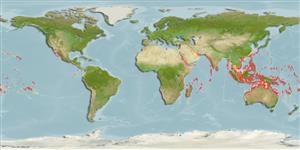>
Gobiiformes (Gobies) >
Gobiidae (Gobies) > Gobiinae
Etymology: Paragobiodon: Greek, para = the side of + Latin, gobius = gudgeon + Greek,odous =teeth (Ref. 45335).
More on author: Rüppell.
Environment: milieu / climate zone / depth range / distribution range
Écologie
marin récifal; profondeur ? - 47 m (Ref. 86942). Tropical; 30°N - 32°S
Indo-Pacific: Red Sea and East Africa to the Marquesan and Tuamoto islands, north to the Ryukyu Islands, south to Lord Howe Island.
Taille / Poids / Âge
Maturity: Lm ? range ? - ? cm
Max length : 4.0 cm TL mâle / non sexé; (Ref. 4343)
Description synthétique
Clés d'identification | Morphologie | Morphométrie
Épines dorsales (Total) : 7; Rayons mous dorsaux (Total) : 8 - 9; Épines anales: 1; Rayons mous anaux: 9 - 10. Head reddish-orange; body and fins black (Ref. 1602); characterized further by having ctenoid scales except cycloid on abdomen; scaleless head and nape with bristle-like papillae; complete pelvic fin frenum and basal membrane; longitudinal scale series 23-25; depth of body at level of pelvic fins 3.0-3.2 in SL (Ref. 90102).
Lives among branches of Stylophora coral. Monogamous (Ref. 52884). Usually in small groups, also found in lagoon and seaward reefs in 1-10 m (Ref 90102).
Life cycle and mating behavior
Maturité | Reproduction | Frai | Œufs | Fécondité | Larves
Bi-directional sex change has been confirmed for this species (Ref. 103751). Monogamous mating is observed as both obligate and social (Ref. 52884).
Maugé, L.A., 1986. Gobiidae. p. 358-388. In J. Daget, J.-P. Gosse and D.F.E. Thys van den Audenaerde (eds.) Check-list of the freshwater fishes of Africa (CLOFFA). ISNB, Brussels; MRAC, Tervuren; and ORSTOM, Paris. Vol. 2. (Ref. 4343)
Statut dans la liste rouge de l'IUCN (Ref. 130435: Version 2024-2)
Menace pour l'homme
Harmless
Utilisations par l'homme
Pêcheries: commercial; Aquarium: Commercial
Outils
Articles particuliers
Télécharger en XML
Sources Internet
Estimates based on models
Preferred temperature (Ref.
123201): 24.7 - 29, mean 27.9 °C (based on 902 cells).
Phylogenetic diversity index (Ref.
82804): PD
50 = 0.5156 [Uniqueness, from 0.5 = low to 2.0 = high].
Bayesian length-weight: a=0.01995 (0.00906 - 0.04395), b=3.01 (2.83 - 3.19), in cm total length, based on all LWR estimates for this body shape (Ref.
93245).
Niveau trophique (Ref.
69278): 3.1 ±0.3 se; based on size and trophs of closest relatives
Résilience (Ref.
120179): Haut, temps minimum de doublement de population inférieur à 15 mois (Preliminary K or Fecundity.).
Fishing Vulnerability (Ref.
59153): Low vulnerability (10 of 100).
Nutrients (Ref.
124155): Calcium = 248 [101, 544] mg/100g; Iron = 1.21 [0.58, 2.60] mg/100g; Protein = 17.8 [15.7, 19.7] %; Omega3 = 0.133 [0.048, 0.300] g/100g; Selenium = 32.4 [12.8, 73.4] μg/100g; VitaminA = 79.9 [17.8, 361.3] μg/100g; Zinc = 2.67 [1.61, 4.32] mg/100g (wet weight);
